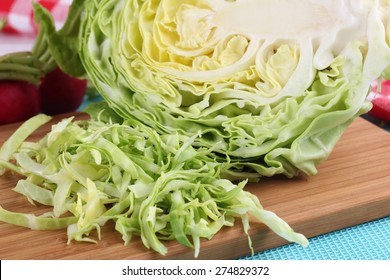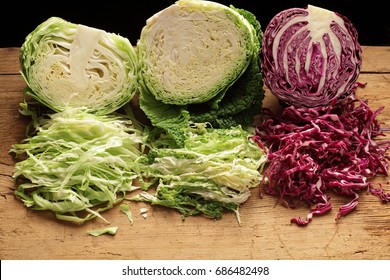The top benefits, nutritional values, Uses and storage of Cabbage
Cabbage has a round shape and is composed of superimposed leaf layers. It is a member of the food family traditionally known as cruciferous vegetables and is very closely related to kale, broccoli, collards and Brussels sprouts. Cabbage and all of its fellow cruciferous vegetables all belong to the family of plants called the Brassicaceae. Cabbage can vary in color from green to red and purple, and the leaves can be smooth or wrinkled. The health benefits of cabbage include its frequent use as a treatment for constipation, stomach ulcers, headaches, obesity, skin disorders, eczema, jaundice, and scurvy. It also helps prevent or delay the onset of rheumatism, arthritis, gout, eye disorders, heart diseases, and Alzheimer’s disease.
1. Antioxidant-Related Health Benefits of Cabbage
Cabbage contains manganese and vitamin C and lots of antioxidants like polyphenols. It helps in reducing oxidative stress.
2. Anti-Inflammatory Benefits of Cabbage
Red Cabbage contains anthocyanins which is an anti-inflammatory compound that is very beneficial for the body.
3. Glucosinolates and Cancer Prevention from Cabbage
Cabbage contains Glucosinolates, antioxidants and anti-inflammatory properties which reduces the risk of cancer such as bladder cancer, breast cancer, colon cancer, and prostate cancer.
4. Digestive Tract Support of Cabbage
Cabbage protects from stomach ulcers as it contains glucosinolates, antioxidant polyphenols, and the amino acid-like substance called glutamine. It improves the digestion and prevents other stomach problems.
5. Cardiovascular Support from Cabbage
Red cabbage supports the cardiovascular health. It also supports liver health, lowers cholesterol and reduces the risk of atherosclerosis.
6. Protection from radiation therapy with cabbage

Cabbage contains 3,3′-diindolylmethane (DIM) which protects from harmful effects of radiation. It also reduces cancer.
7. May Lower Blood Pressure with cabbage
Cabbage contains potassium which lowers the blood pressure and reduces the risk of heart disease.
8. Improves Brain Health with cabbage
Cabbage contains vitamin K and anthocyanins which give a strong boost to mental function and concentration. It also protects the nerves from damage and decay and improves the defence against neurodegeneration.. Cabbage, being rich in iodine, also helps in the proper functioning of the brain and the nervous system, along with keeping the glands of the endocrine system in proper condition.
9. Improves Bones with cabbage
Cabbage contains calcium, magnesium and potassium which protects the bones from degradation and the onset of conditions like osteoporosis and general bone weakening.
10. Reduces Muscle Aches with cabbage
Cabbage reduces the muscle pain when certain bacteria ferment the sugars in cabbage during the preparation of sauerkraut, lactic acid is released. It isn’t the easiest compound to find in a diet, but it has been shown to reduce muscle soreness and aches.
11. Speeds-up Healing with cabbage
Cabbage contains sulfur which protects from infections and speeds the healing process. It also reduces the frequency and severity of ulcers.
Cabbage can be eaten at any time of day. Radishes, turnips, rutabagas, broccoli and cauliflower goes well with cabbage.

How to buy and store cabbage
Buy cabbage which are fresh, firm, compact. Cabbage can be stored in a refrigerator for few days.
Ways to use cabbage
Cabbage can be used in various culinary uses and can be incorporated into our daily diet in the following ways:
- Salads: Cabbage can be shredded into salads with salt and other spices.
- Soups: It can also be boiled into a soup and served hot.
- Stews: It can be served raw or steamed into a stew with water and salt.
- Braise red cabbage with a chopped apple and red wine. This is a child-friendly dish since the alcohol (but not the flavor or the flavonoids) will evaporate.
- Combine shredded red and green cabbage with fresh lemon juice, olive oil, and seasonings such as turmeric, cumin, coriander, and black pepper to make coleslaw with an Indian twist.
Uses of cabbage
1. Treats Stomach Ulcers
Cabbage is effective at treating a stomach ulcer. Cut half of a raw head of cabbage and two carrots into small pieces. Put them in a blender to extract the juice. Drink ½ cup of this juice before each meal and at bedtime. Repeat daily for a few weeks.
2. Cures Engorgement of the Breasts
Dealing with engorgement of the breasts during breastfeeding is nothing less than a nightmare for a mother. Breast engorgement occurs when your breasts become painfully overstocked with milk. You can use cabbage leaves to reduce the swelling and pain arising from moderate to severe engorgement of the breasts.
The antibiotic and anti-irritant properties of cabbage help reduce tissue congestion by dilating local capillaries and improving the blood flow in the area.
- Put a few cabbage leaves in the refrigerator for 30 minutes.
- Place a cold cabbage leaf on the engorged breast.
- When the leaf reaches room temperature, replace it with a new one.
- Do this a few times daily until the engorgement subsides.
3. Heals Sprained Ankles
If you’ve sprained your ankle, cabbage is effective in getting you the much-needed relief. Its anti-inflammatory effect helps reduce the swelling triggered by sprains and broken bones.
- Remove the outer leaves from the head of cabbage.
- Using a rolling pin, gently crush the leaves so that juice is released.
- Wrap the cabbage leaves in foil and warm them in the oven.
- Put the warm cabbage leaves over the painful area.
- Secure them with a gauze bandage, and then cover the area with plastic wrap to retain its warmth.
- Leave it on for 30 minutes.
- Use this remedy twice daily for a few days.
4. Cabbage For Ingrown Toenails
Cabbage is used in to remove pus from ingrown toenails and eliminate the infection. You need to place several leaves around the infected toe and secure with a cloth bandage. Cover the infected tie with a sock and leave it overnight. Remove the leaves in the morning and repeat the process overnight. Apply some epsom salt soak in the morning. Continue this process for a few days to see a vast improvement in your toe infection.
5. Cabbage Wrap For Swollen Feet
If you have a swollen foot or maybe your feet are sore in nature, then cabbage is the doctor that you need to go to! Cabbage helps in alleviating pain, and also reduces the swelling in your feet. Cool white or green cabbage leaves in the freezer until they get chilled. Wrap them around your swollen feet and sit with your feet elevated for 30 minutes. The cabbage will draw out excess fluid and bring relief to your sore feet
6. Cabbage Face Mask For Sagging Skin
Start by taking 4 Tbsps of minced cabbage. Put them in the blender. Get one egg white egg, crack it, and use only the white portion.Then mix everything in the blender and add the 2 teaspoons of rice or besan flour. Power up the blender until you have a smooth yet sticky paste-like mixture. When your mask is ready, remember to start with a dry clean face, then apply evenly on face and neck (avoid the eye and mouth areas). Use a cotton pad or gauze all over your face. After a while, you can massage your face in circular motions for about 2 minutes. Then let it sit for 15-20 minutes. Now wash it off with lukewarm or cold water. Then pat dry. You can follow it up with moisturizer if you like.
Season in which cabbage is available
Cabbage is available in winters i.e., in december.
How to make Bandh (patta) gobi aloo sabji
INGREDIENTS
1 small cabbage
1 medium size potato
1 cup green peas Frozen / fresh
1 large onion chopped
3 – 4 Cloves Garlic chopped
1 tsp Ginger paste or finely grated or cut
1 – 2 Green Chilli ; chopped
few Coriander leaves chopped
1 1/2 teaspoons Turmeric / Haldi powder
1 teaspoon Coriander powder / Dhania powder
1/2 teaspoon Cumin Powder/ Jeera powder
1 teaspoon Garam Masala powder
1/2 teaspoon Red chilli powder powder
1 teaspoon Cumin seeds
1 Bay Leaf / Tej patta
to taste Salt
2-3 tbsp Oil
INSTRUCTIONS
Cut Cabbage into long strips and chop potatoes to small dice.
Heat oil in a pan /kadai over medium heat, add cumin seeds ,tej patta and let it get splutter.
Add chopped onion followed by garlic, ginger and green chillies to the pan and cook until onions are translucent.
Then add potatoes and green peas. Add some salt,turmeric powder and saute for 1-2 mins. Close and cook over low flame mixing well in between.
Once the potatoes are 30 percent cooked, add cabbage. Saute for 1-2 mins ,close and cook over low flame mixing well in between.
Once the veggies are cooked 75 percent, add coriander powder, cumin powder, amchoor powder,red chilli powder and salt to taste. Stir the masala well. Cook for 2-3 mins uncovered, let the veggies take the masalas in and the moisture get evaporated.
Finally add garam masala powder and coriander leaves , mix and switch off.
Serve hot Cabbage potato peas sabzi with hot roti or with rice or as sandwich.
How to make Cabbage Poriyal
Ingredients
- Oil – 1 tsp
- Mustard seeds – 1/2 tsp
- Chana dal – 1 tsp
- Broken Urad dal – 1/2 tsp
- Jeera – 1/2 tsp
- Curry leaves – 1 sprig
- Green chilli – 1 large (finely chopped)
- Garlic – 4 cloves (sliced)
- Onion – 1/2 medium (sliced)
- Cabbage – 1/2 medium (finely chopped or sliced)
- Salt – 1/4 tsp (adjust per taste)
- Grated coconut – 2 tsp
Instructions
- First heat a large pan with oil and add the mustard seeds. Once it splutters, add the chana and urad dal. Once the dal start to change color add the jeera, curry leaves, green chilli and continue to saute until the dals turns golden brown in color.
- Now add the garlic, onion and saute until the onion turns translucent.
- Add the cabbage, salt and saute for 1 min. Cook covered in medium flame for about 5 mins until the cabbage is cooked. Increase the flame to high and saute for 1-2 mins until the cabbage is completely dry.
- Add the coconut and mix well. Turn off the flame.
- Serve hot as a side for rice and gravy.
Notes
- – Adjust the spiciness (green chilli) as per your taste.
- – Slightly undercook the cabbage. It would taste good if it still slightly crunchy.
- – Coconut is optional, however I strongly recommend adding since it gives a wonderful flavor to the poriyal.
- – You can also use dry red chilli instead of green chilli.
Safety profile for using cabbage
Cabbages can also have a few side effects on your body, including the following:
- Bloating
- Foodborne illness
- Goiter
- Iodine intake
- Flatulence
- Diarrhea
- Drop in blood sugar levels
- Colic
Fun facts about cabbage
- Cabbage is a cruciferous vegetable.
- A chemical in cabbage may protect against the negative effects of radiation.
- The sulforaphane found in cabbage may help protect against cancer.
- Half a cup of cooked cabbage contains 81.5 micrograms of vitamin K.
- Cabbage is any of the various plants of the Capitata Group of the species Brassica.
- It is a leafy green, red (purple), or white (pale green) biennial plant grown as an annual vegetable crop for its dense-leaved heads.
- We don’t know for certain where cabbage appeared for the first time because many plants belong to the family of “brassicas”, they grow around the world and today’s cabbage descends from them.
- The most common theory is that The West cabbage is domesticated in Europe some 3,000 years ago from its wild predecessors that had thick leaves that retained water which allowed them to survive in colder places with less water. In the East, cabbage is used since the 4,000 BC and was cultivated in North China. These variants were nonheading cabbages and were domesticated by Celts of central and western Europe.
- The ancient Greeks had some varieties of cabbage, as mentioned by Theophrastus, although whether they were more closely related to today’s cabbage or to one of the other Brassica crops is unknown.
- The first round-headed cabbages appeared in 14th-century England, and they became more and more popular as cuisine throughout Europe.
- The first cabbage in America was brought by a French explorer Jacques Cartier on his third voyage 1541 – 1542.
- Today, China is the largest producer of cabbage, followed by India and Russia, which is the biggest consumer of cabbage.


Leave a Reply